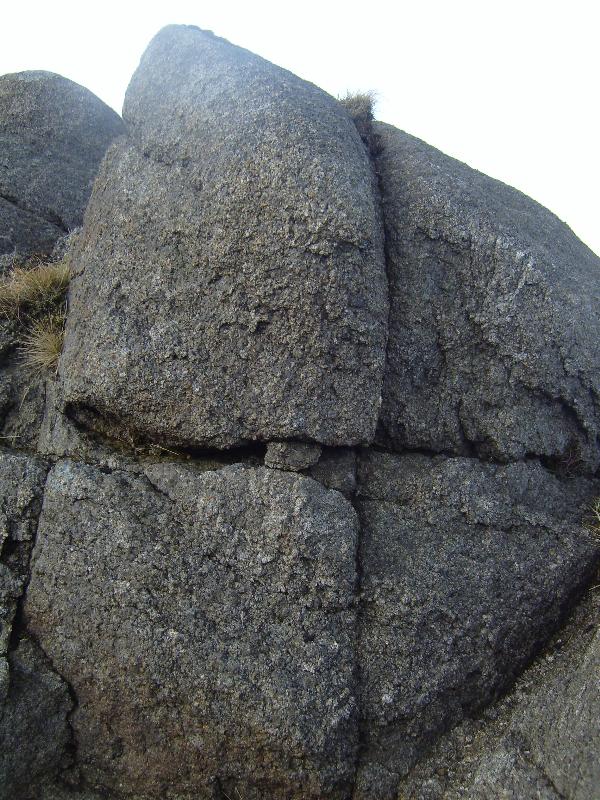About 60 million years ago, in a time geologists call the Tertiary Period the Mourne Mountains started to be born within the Earth’s crust. The surface layers of this region at this time were slates and shales, a massive piece of which broke off and slowly sank deeper into the crust. This left a huge cavity which was filled in stages by magma (molten material formed in the furnace-like conditions inside the crust). The magma slowly cooled to form a hard igneous rock known as granite. During the cooling process vertical cracks or joints formed in the granite – later, horizontal joints also formed giving the granite a blocky appearance.

For many millions of years the granite remained hidden below the shales. However, with the passage of time these overlying rocks were gradually removed by erosion and weathering to reveal the granite underneath. Granite, being a hard resistant rock has better withstood more recent wearing away leaving it head and shoulders above the surrounding lowlands which were composed of “softer” rocks. The Mourne Mountains had arrived.

Now, let’s turn our attention to Ireland’s climate. Like our landscapes, it too, has changed – ranging from hot desert to fridge-like conditions. In recent geological times the Earth has experienced long periods when temperatures dropped below freezing point to create what has been called the Ice Age. In fact, Ireland has had several Ice Ages (with warmer interludes called Inter-glacials in between) – the most recent of which lasted from about 100,000 until 10,000 years ago.
As temperatures dropped snow fell upon snow all year round and, in the Mourne Mountains it accumulated to a considerable depth. The upper layers of snow weighed heavily on underlying snow turning it to ice. This ice, in the form of glaciers, moved down the lines of former river valleys. As the glaciers crept downwards and outwards they picked up stones to become formidable agents of erosion – a bit like giant rasps remorselessly grinding away at, and changing forever the land over which they travelled. The high hollows that were the birth places of glaciers were deepened to form corries or Pots eg Pot of Legawherry; mountain spurs had their ends cut off eg Spellack and former “V” shaped river valleys became “U” shaped glaciated valleys eg Silent Valley.
When the cold intensified the valley glaciers spread on to and over the lowlands to form ice sheets. An ice sheet from Scotland joined the Irish ones so that eventually almost all of Ireland was covered with a layer of ice several hundreds of metres thick. Slowly, but relentlessly, these ice sheets shaped our landscape in a distinctive way to create features including round-topped mountains eg Slieve Donard; roche moutonnees eg Hare’s Castle ; erratics eg Cloughmore Stone and the drumlins which cover much of Co. Down.
It is difficult to be precise, but research suggests that vast ice sheets from Donegal and Scotland sent “arms” of ice towards the Mournes – not only spreading amoeba-like around its mountains but also sending “fingers” along its valleys and through its cols. One “finger” slid between Slieve Bernagh and Slievenaglogh at the place, we today, call the Hare’s Gap. It ground down and flattened its floor and it utilized the joints in the granite to pluck away large blocks from its sides to form vertical cliffs. The end result is the best example of an ice transfluence col in the Mourne Mountains.
About 14,000 years ago the climate started to get warmer. The ice retreated and the Hare’s Gap with its distinctive bite shaped profile was left more or less as we see it today. Originally there would have been striations on its sides – scratches caused by pebbles being rubbed into the granite – however, recent weathering has removed or softened their outlines.
And, could it all happen again? In spite of all the talk about global warming some geographers suggest we might just be in another Inter-glacial period – with a further Ice Age just around the corner!

The Hare’s Gap is most easily approached from Trassey car park and following the Trassey Track south-eastwards into the mountains. There is no path for the final few hundred metres which is quite steep and bouldery . You can also walk in from Meelmore Lodge (there is a parking charge) which provides toilet and cafe facilities. Allow at least 2-3 hours for the walk there and back. Remember, this is a mountainous area so wear hill walking boots and appropriate clothing, carry food and water and bring a map and compass.
To claim this EarthCache you must Email the answers to questions 2, 3 and 4 to me.
1. It would be nice if you would include a photograph showing yourself with your GPSr taken beside the stile in the Gap - however, this is optional and not required to claim the cache.
2. Using your GPSr work out the number of metres/feet across the floor of the Gap from one side to the other.
3. You will find a big stone with a dimple on top (it often contains rainwater) at N54*11.413; W005* 58.413. This dimple was once part of a bubble created as the magma cooled and hardened. Measure the diameter of the dimple.
4. At N54*11. 408, W005*58.419 there is a large rectangular "boulder" with joints which, when looked at from above, resemble a "T". (see photograph)

Estimate the top surface dimensions of this" boulder". This "boulder" may have fallen from the cliffs above - however, some other boulders in the Mourne area are sometimes called "stranger stones" - suggest why.
Only after completion of all four tasks and confirmation of your correct answers should you log a find. Please do not reveal the answers to 2, 3 and 4 in your log or other photographs.